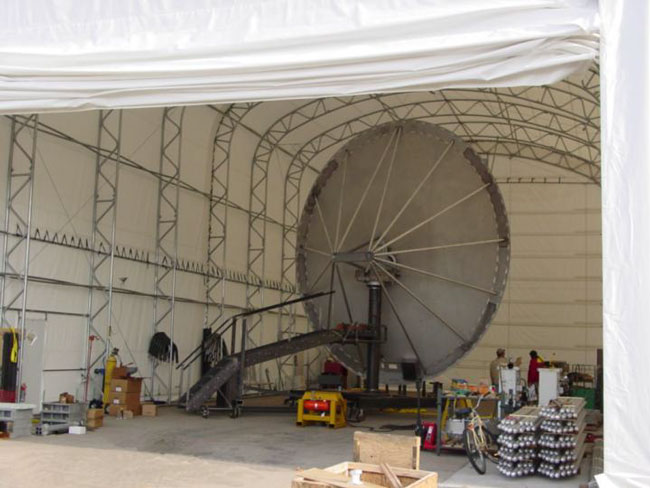Allen Telescope Array Update

The tent looked so big when it was first installed. The vaulted top stands 35 feet above the ground. It is 40 feet wide. The door is almost 30 feet high. It's gleaming white. In short, it's a perfect place within which to build the antennas for the Allen Telescope Array.
Well, when you build an entire 20 x 24 foot antenna on a pedestal inside of it, all of a sudden the tent doesn't look so big. In fact, the door looks a skosh too small. But the assembly does fit in the tent; even the somewhat tricky "flip" needed in the assembly process cleared the ceiling. It also fit through the door, with an inch or two to spare, just as we knew it would. But we still sighed a bit in relief. Our factory was in production! And it all went superbly, a tremendous credit to our chief mechanical engineer, Matt Fleming, who conceived and designed the antenna mount and all of the associated fixtures and hardware.
It has been very gratifying to begin the emplacement of antennas at the Hat Creek Radio Observatory site, something that we've been working towards for several years now. The entire antenna gets assembled using a series of "fixtures" inside of this tent. A fancy forklift then picks up the antenna (complete with the subreflector, cabling and electronics), carries it out to the waiting pedestal and sets it carefully in place.
This procession will continue until the 42nd antenna in Phase I goes up. After a short hiatus, the procession will continue as we proceed towards our full complement of antennas.
The new cryogenics on the log-periodic feed have been working flawlessly, cooling the small low-noise amplifiers that sit at the focus of each antenna to a very chilly 50 K, about 30 K lower than our design goal. Since these amplifiers are the first electronic components that the received electromagnetic waves have seen in possibly billions of years, we treat them gently with these amplifiers. The low temperatures assure that the thermal wiggles of the electrons in the device don't add much noise to the weak signal.
Once the signals have been amplified, we can treat the signal a bit more harshly, as we convert the microwave signals to optical signals and transport them back to the lab, where they are converted back to microwave signals and digitized. Once the signals are in the digital domain, we can treat them with impunity. In fact, we clone them repeatedly. In this way, we can send bit-perfect copies to several back-end processors that can individually handle the data, producing many types of data products useful for SETI researchers and astronomers.
So, from the large machines installing the big structures, which gently receive the incoming wave, to the small machines that pick and place the tiny-yet-powerful digital electronics, which manipulate the signals, the progress is tangible. We all look excitedly to the near-term and the burgeoning capability of this pioneering new telescope.
Breaking space news, the latest updates on rocket launches, skywatching events and more!
- Cranking Up the Allen Telescope Array
- The Search Continues with the Allen Telescope Array
